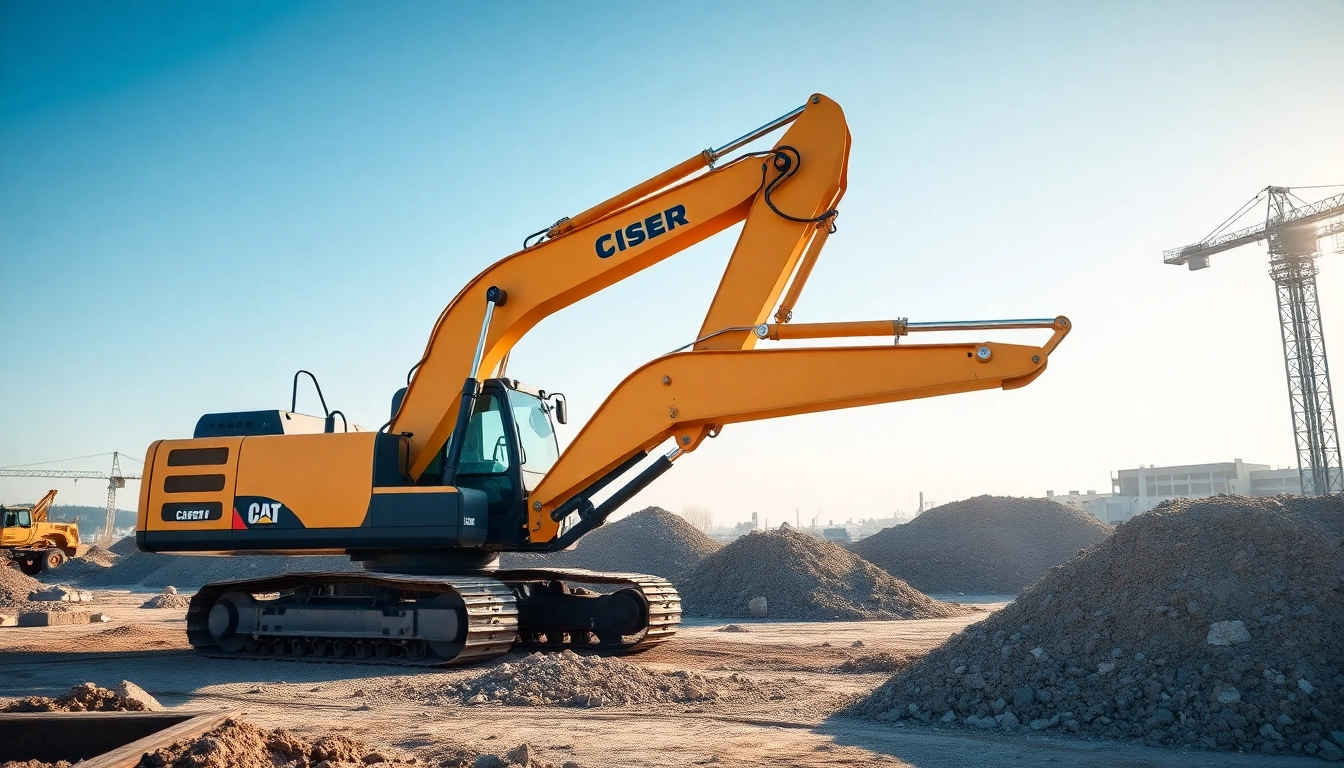Understanding Excavator Rental: A Complete Guide for Buyers
In the dynamic landscape of construction, landscaping, and infrastructure development, excavators stand as indispensable tools that facilitate efficient digging, lifting, and earthmoving operations. Whether you’re a contractor managing large-scale projects or a DIY enthusiast undertaking a home renovation, having access to reliable excavator equipment can significantly impact project timelines and budgets. As the demand for flexible and cost-effective solutions grows, excavator rental has emerged as a strategic choice, offering versatility without the burden of ownership. This comprehensive guide aims to navigate you through the nuances of excavator rentals, empowering you to make informed decisions tailored to your project’s specific needs.
Types of excavators available for rent
Excavators come in various configurations designed to cater to diverse project requirements. When considering rental options, understanding the fundamental types is crucial to selecting the right equipment for your tasks.
Mini and Micro Excavators
Typically weighing less than 6 tonnes, mini excavators are perfect for tight spaces and precision work. Micro excavators, which usually weigh less than 1 tonne, excel in highly confined environments such as indoor renovations or urban landscaping. For instance, a 0.75-ton micro excavator might be ideal for indoor basement excavations, allowing access through narrow doorways and minimal ground disturbance.
Standard and Midi Excavators
Standard excavators range from 6 to 20 tonnes, offering a balance of power and maneuverability. Midi excavators, often in the 5-10 tonne range, are versatile units suitable for general construction, landscaping, and trenching projects. Their size enables efficient work on medium-sized sites while remaining manageable for operators with varying levels of experience.
Large and Heavy-Duty Excavators
Heavy-duty excavators, exceeding 20 tonnes, are designed for large-scale projects such as quarrying, major infrastructure, and deep excavations. These machines deliver high productivity but require skilled operators and substantial site space for safe operation.
Specialized Excavators and Attachments
Beyond standard designs, many rental providers offer excavators equipped with specialized attachments such as breakers, grapples, and augers. These attachments expand the utility of excavators, enabling tasks like demolition, material handling, and drilling to be performed with a single machine.
Choosing the right size and model for your project
Selecting the appropriate excavator size and model is critical for optimization in work efficiency, safety, and cost management. A well-matched machine ensures the project stays on schedule and within budget.
Assessing Project Scope and Site Conditions
Start by evaluating the scope of your project—depth and volume of excavation, site accessibility, and environmental constraints. For instance, tight urban spaces necessitate compact machines like mini or micro excavators, while large open sites can accommodate heavier, more powerful equipment.
Understanding Load and Reach Capabilities
Determine the lift capacity and maximum reach required to complete your tasks efficiently. Overly large equipment can lead to unnecessary fuel costs and maneuverability challenges, whereas undersized machines may prolong work or fail to meet specifications.
Matching Equipment Features to Project Needs
Consider features such as hydraulic flow rates, digging depth, and maneuverability. For example, projects involving trenching may require excavators with extended booms, while site clean-up might favor models with easy attachment swaps and high breakout force.
Case Study: Small Urban Garden Renovation
For a city-based garden overhaul, a 1.5-ton mini excavator with narrow tracks and precise controls would be ideal, offering the mobility to work within confined spaces without damaging surrounding structures.
Advantages of renting vs. buying excavators
Choosing between renting and purchasing excavators involves careful analysis of financial, operational, and logistical factors. Rental options are increasingly appealing due to flexibility and lower upfront costs, particularly for intermittent use.
Cost-Effectiveness
Renting eliminates large capital expenditures associated with purchasing equipment. It also reduces ongoing costs related to maintenance, storage, and depreciation. For example, a contractor might pay a daily rental fee that includes servicing, whereas owning entails maintenance costs regardless of usage.
Access to the Latest Technology and Equipment
Rental companies regularly update their fleets, providing access to newer, more efficient models that incorporate advanced technology such as GPS-guided digging or fuel-saving systems. This access can enhance productivity and reduce operational costs.
Flexibility and Scalability
Rental arrangements offer adaptability to project demands—scaling machinery size up or down, or switching models as needed. It’s particularly advantageous for projects with fluctuating workloads or seasonal variations.
Risk Mitigation and Maintenance Management
Maintenance, repairs, and technical support are typically included in rental agreements, minimizing downtime and operational risks. Conversely, owning equipment demands a dedicated maintenance schedule and contingency planning for unexpected breakdowns.
Example Comparison: Rental vs. Purchase for a Mid-Sized Building Site
A construction firm renting a 10-ton excavator for six months might pay significantly less than purchasing outright, while also avoiding the costs of maintenance and eventual resale. The adaptability and reduced risk make rentals a pragmatic choice for many projects.
How to Select a Reliable Excavator Rental Provider
Partnering with a reputable rental provider ensures equipment availability, safety, and service quality. Careful vetting of rental companies is vital to avoid delays, hidden costs, and equipment failure.
Factors to consider when comparing rental companies
- Reputation and Reviews: Investigate customer feedback and industry reputation to gauge reliability.
- Range of Equipment: Ensure the provider offers a wide selection of models and attachments suited to your needs.
- Availability and Delivery Options: Confirm prompt access to machinery, including delivery and pickup services.
- Support and Technical Assistance: Check for on-site support, operator training, and responsive customer service.
Assessing equipment quality and maintenance standards
High-quality, well-maintained machinery reduces downtime and safety risks. Enquire about the provider’s maintenance protocols, routine inspections, and certification standards. Modern rental fleets often include regular servicing, and equipment should display recent inspection tags and calibration records.
Understanding rental terms and pricing structures
Clear communication on rental rates, deposit requirements, insurance, fuel policies, and overtime charges is essential. Some providers offer all-inclusive packages, simplifying budgeting. Always review the rental agreement thoroughly to understand cancellation policies and liability clauses.
Best Practices for Safe and Efficient Excavator Use
Maximizing safety and productivity requires adherence to established protocols before, during, and after excavation activities.
Preparing your site and planning your workflow
Conduct a comprehensive site assessment—mark underground utilities, assess ground stability, and clear obstacles. Develop a detailed work plan, including access routes, lifting sequences, and safety zones to prevent accidents.
Operator safety tips and equipment handling
Qualified operators should undergo training compliant with local safety standards. Always wear appropriate PPE, such as helmets, high-visibility clothing, and safety boots. Before operation, conduct machine inspections, checking fluid levels, controls, and attachments. Maintain clear communication using radios or signals, especially on busy sites.
Maintenance and post-rental inspections
Perform routine inspections during use, noting any damage or irregularities. Post-rental, inspect the equipment for wear and tear, ensuring repairs are addressed before returning. Proper documentation supports compliance and helps maintain high safety standards.
Maximizing Rental Value: Cost and Performance Optimization
Optimizing the return on your rental investment involves strategic planning and the integration of technology and accessories to enhance productivity.
Scheduling and duration considerations for cost savings
Align rental periods with project phases to avoid unnecessary costs. Long-term rentals often benefit from negotiated discounts. For instance, extending a rental period for several months may reduce daily rates, offering significant savings.
Integrating technology and attachments for better results
Attachments such as hydraulic breakers, augers, and rippers expand machine capabilities, enabling a multifaceted approach to tasks. Utilizing GPS or telematics systems can improve operational efficiency, track usage, and facilitate maintenance scheduling.
Measuring project success and rental ROI
Track key performance indicators such as project completion time, material costs, and machine uptime. Analyzing these metrics enables better planning for future projects and helps justify rental expenses as an investment toward project success.
Emerging Trends in Excavator Rental and Construction Equipment
The industry is rapidly evolving, integrating eco-conscious solutions and technological innovations to meet modern demands.
Eco-friendly and fuel-efficient excavator options
Manufacturers are developing hybrid, electric, and compressed natural gas (CNG) excavators. These options reduce emissions, fuel costs, and environmental impact—aligning with UK’s sustainability goals.
Technological innovations improving operational efficiency
Advancements such as remote diagnostics, automation, and smart sensors enable proactive maintenance, reduce downtime, and improve safety. For example, telematics systems can monitor machine health in real-time, alerting operators to issues before failure occurs.
Future outlook for the UK rental market and industry best practices
The UK market is expected to see continued growth driven by infrastructure projects, green initiatives, and technological adoption. Industry best practices will emphasize safety standards, environmental responsibility, and digital integration, ensuring operators and providers adapt to changing regulations and market conditions.









